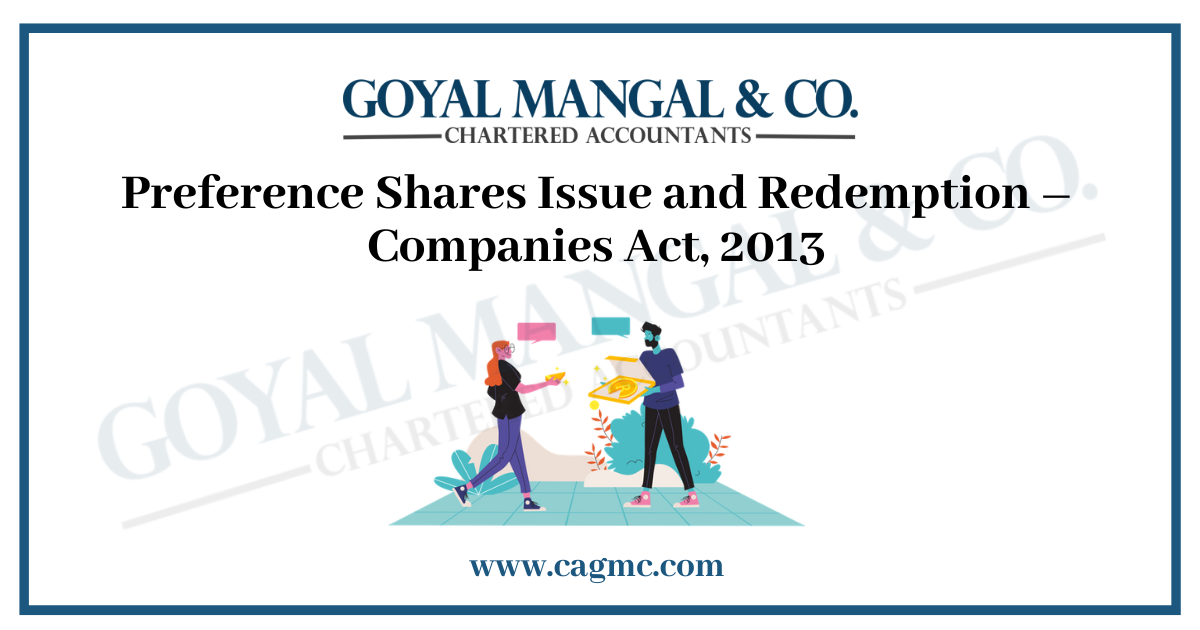
There are 2 types of shares in any company firstly Equity share or Common Stock and secondly Preference shares or Preferred stock. Shareholders are considered to be the real owners of the Company as they have voting rights in the company while preferred shareholders do not have the right to vote in all decisions under normal circumstances. However, where a dividend regarding preferential shares has not been paid for two years or more, that category of preferred shareholders shall have the right to vote on all decisions set before the company. Preferred shareholders are given priority on dividend payments and refunds upon termination. The dividend rate on equity shares changes every year as it depends on the amount of profit available to the company. On the other hand, Preferred Shares hold a fixed rate or fixed amount as profit. This article focuses on Preference Shares Issue and Redemption – Companies Act, 2013.
Meaning of Preference Shares Issue
A company may issue redeemable preference shares in accordance with Rule 9 of the Companies (Share Capital and Debentures) Rules, 2014 and Section 55 of the Companies Act, 2013 (the “Act”). Section 55 forbids the issuance of irredeemable preference shares (1).
Modes through which preference shares can be issued:
- Right Issue – Section 62(1)(a)
- Preferential Allotment – Section 62(3) (c) read with Section 42
- Private Placement – Section 42
Redeemable Preference Shares’ Duration
According to Section 55(2) of the Act, a company limited by shares may issue preference shares that are redeemable within 20 years of the date of issuance. A business that develops and manages infrastructure projects may issue preference shares for a period longer than 20 years but not longer than 30 years, provided that the preference shareholders have the option to redeem at least 10% of those shares on a proportionate basis each year starting with the 21st year or earlier. The projects mentioned in Schedule VI of the Companies Act, 2013, are referred to as “infrastructure projects.”
Preference Share Redemption
In terms of Act 9 (6) of the Companies (Share and Debt) Act, 2014, a Company may use its preferred shares only on the terms of its issuance or separately after the relevant authorities of preferred shareholders.
The preference share may be redeemed
- At a specified time or event;
- Anytime by company’s option
- At any time by the shareholder option
Preference shares can be redeemed out of
- Benefits of profits
- New profits from stocks
Terms of Redemption – Terms of Section 55 (2) of the Act
The following are the Terms of Redemption under Section 55 (2) of the Act.
- Preference Shares shall be used for the benefit of the acquired company for profit or for the benefit of new shares issued for the purposes of that release.
- Such shares will only be used once they have been paid in full.
- Where such shares are proposed to be used for the benefit of the company, then an amount equal to the minimum number of shares to be used, will be transferred to the Capital Redemption Reserve Account.
- In the event that such companies comply with the accounting standards in accordance with the provisions of Section 133, the premium paid on the release will be provided to the company’s profits before the shares are used.
Procedure of Preference Share Redemption
The following is the procedure for Preference Share Redemption:
- Step 1: Call of Board Directors – Issued Board Meeting Notice to all company directors at least 7 days prior to Board Meeting.
- Step 2: Hold a Board Meeting – To Succeed the Board’s decision to authorize the use of popular stocks.
- Step 3: Inform the Preferred Shareholders – All interested shareholders will be notified individually regarding the proposed redemption.
- Step 4: Transfer to a Redemption Fund – Transfer the normal amount of shares to; be used in a reserve fund called the Capital Redemption Reserve from the company’s dividends if the shares are deducted from the company’s dividends.
- Step 5: Making a Payment to Preferred Shareholders – Paying the redemption amount and premium (if any) to eligible shareholders.
- Step 6: Submitting Redemption Notice and Registrar – Notice of redemption must be lodged on the Form SH-7 register within 30 days of receipt of preferred shares.
- Step 7: Update Member Registration –Make the required entries in the member registry.
Redemption for the Company’s profit
Redemption Premium for Preference Shares
The Company’s profits alone must be used to pay the premium owing upon redemption of Preference shares. However, in the following two circumstances, premium due on Preference shares may be paid not only from the P&L Account but also from the Securities Premium Account:
- The redemption of preference shares issued on or before the effective date of this Act.
- If the business does not adhere to accounting standards.
If a company is unable to redeem a Preference Share
Unredeemed preference shares are the shape that shares take when a company is unable to redeem any preference shares or pay any dividends on such shares in accordance with the conditions of issuance. A company may issue additional redeemable preference shares equal to the amount due, including the dividend thereon, in respect of the unredeemed preference shares with the consent of the holders of 3/4th of the value of such preference shares and the approval of the National Company Law Tribunal (NCLT) on a petition made in this regard. Upon the issuance of such additional redeemable preference shares, the unredeemed preference shares shall be deemed to have redelivered.
People who have not approved the issuing of further redeemable preference shares must have their preference shares redeemed promptly by the NCLT.
Conclusion
Preferred shares are a good tool for a company that wants an investment that does not diminish the voting rights or control of the company. At the same time, it provides preferred shareholders with guaranteed income and dividends and repayment first.







